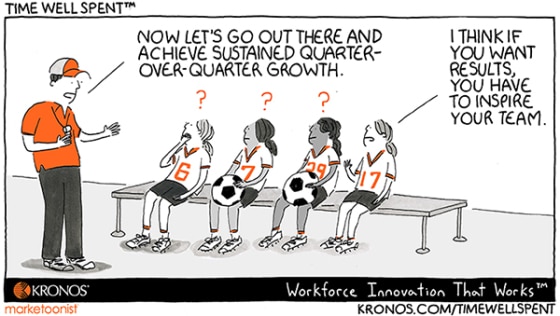Organizational Leaders Must Understand Their Workforce – Friday Distraction
(Editor’s Note: Today’s post is brought to you by our friends at Kronos, a leading provider of workforce management and human capital management cloud solutions. Join me for a special SHRM podcast with Kronos CEO Aron Ain as we chat about “Work Inspired: How to Build an Organization Where Everyone Loves to Work”. Enjoy the article!)

We spend a lot of time telling individuals that the way to get ahead in their career is by being able to speak the language of business. Know business acumen. Talk like the C-Suite. And all of that is true.
But today’s Time Well Spent cartoon from our friends at Kronos reminded me that as leaders, we also need to be able to speak like our workforce. We need to empathize with them and address them in a way they understand. That does not mean talking down or dumbing down the message. It means being able to relate to our workforce.
For example, if a manager is making $100,000/year and the majority of the people in their department make $15.00/hour (or basically $31,200/year), there’s a pretty big disparity there. How is that manager talking about career development? Are they telling employees they should pay to attend classes to improve their skills, knowing they might not have the same amount of discretionary income?
Now for a moment, let’s put the money conversation to the side. In the cartoon, the coach is talking about “sustained quarter-over-quarter growth”. And the players have no clue what the coach is talking about. Managers and leaders need to talk about performance in terms that employees understand. Does the organization share the company’s profit and loss statement with employees? Do employees know what the key performance metrics are for the company?
Finally, one more example. Organizations do better when they build diverse workforces. But obviously, diverse workforces are … diverse. Employees will have different backgrounds and experiences. Everyone in the organization needs to be open to learning about those differences. For instance, Mr. Bartender and I don’t have children. I’ve worked with plenty of people who do. As a manager and a leader, I needed to learn what it’s like to be a working parent so I could be more in tune with my team and co-workers.
When we discuss learning about the business, we’re not just talking about learning the numbers. And when we say that managers need to speak the language of business, it’s not just about using a bunch of financial jargon. It’s about understanding your audience: who they are, what motivates them, and how to build a positive working relationship with them.
19